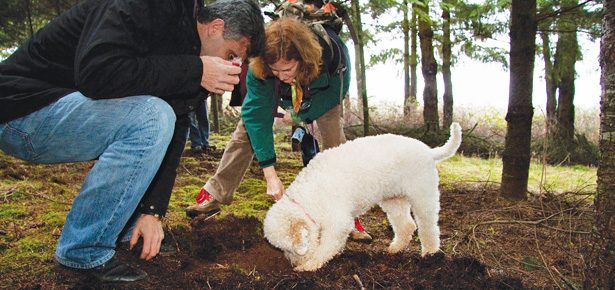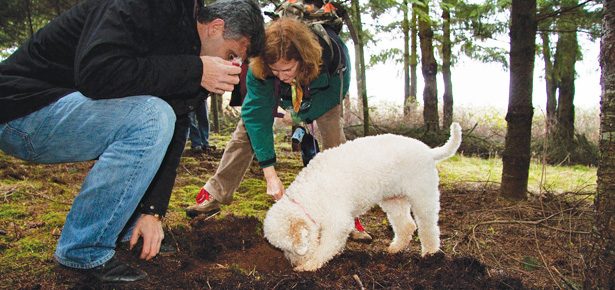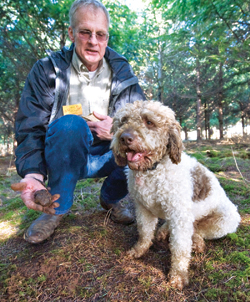

Truffle Hunting with Dogs
Black gold in the hills of Umbria
As dawn broke over the hills of Umbria, the view from the mountaintop was spectacular. Green and yellow fields of sunflowers shimmered in the early morning light, and the small Italian town of Spoleto where we had started our journey seemed like a tiny speck in the distance.
At 5:00 that morning, I had groggily tumbled out of my comfortable bed at a converted fifteenth-century monastery to meet Lorenzo, a local truffle hunter, and his dog, Vida, at a café in the bottom of the valley. Speaking little English, the slim and wiry silver-haired man beckoned me over to his tiny 4×4 Fiat, and we embarked on a hair-raising race up the mountain, careening back and forth around hairpin switchbacks with little regard for the practicality of brakes.
Our mission, should we choose to accept it, was to search out the elusive black truffle—highly prized among gourmands, sometimes fetching thousands of dollars per pound, known to many as “black gold.” Plainly put, a fungus, but one with a reputation far surpassing its lowly underground origins. The black truffle cannot be cultivated and its heady, woodsy aroma can only be enjoyed through the hard work of man and animal searching around the roots of particular types of trees.
It was perfect weather for hunting summer black truffles and, by the time we arrived at the top of the mountain, I was awake enough to start. But truffle hunting had to wait: the hunter was also a shepherd, and his sheep needed to be milked.
I learned that Lorenzo was not a one-dog man. At the summit, we met his grizzled, stooped-over father, who had arrived earlier that morning, and several sheepdogs. These dogs were an integral part of the milking process. Not only did they herd the sheep into the milking pen, but they responded to Lorenzo’s whistles by driving more sheep toward them as he and his father completed milking each of the three dozen sheep by hand.
With the first chore of the day complete, Lorenzo opened the trunk of the Fiat to store a large can full of frothy milk. Then, out leapt the real star of the day, Vida, keen and ready to work. We trotted off into the nearby woods, lands that have been registered to this particular truffle hunter as his and his alone for the purposes of truffle harvesting.
As Lorenzo shouted, “Vai, vai!” (Go, go!), the skinny, medium-sized brownand-white mongrel (who looked like she had just given birth) bounded around among the trees, nose to the ground, not seemingly following any pattern, but occasionally veering suddenly to the left or right and excitedly pawing at the ground. She would dig away until her master arrived with his own digging tool, which resembled a small hoe, eventually to unearth a small, black, unimpressive golf ball-sized nugget of fungus.
Her reward was a little biscuit kept in a bag on the hunter’s hip—and then off she would race, again and again. Soon the man had a handful of truffles, which he tucked carefully into a small cotton bag he wore at his side. He would receive the equivalent of hundreds of dollars from an eager buyer down in the valley.
In years past, female pigs were used to hunt truffles. The aroma a truffle exudes is similar to the male porcine pheromone, and sows excel at rooting out the source of the scent with all the enthusiasm of, well, sows in heat. The only problem is that pigs love to eat truffles. (Let’s not ask the boars about this.) Imagine trying to keep a horny, hungry, 300-pound pig away from a treasured truffle…Not so easy.
Hounds turn out to be just as adept as pigs at locating truffles, but have no interest in chewing them up. My truffle hunter demonstrated his dog’s disinterest by tossing one of the truffles into the woods. She happily fetched it gently in her jaws, once again for the reward of a small bite of biscuit.
Apparently, bitches are easier to train to hunt for truffles, but males are better at finding them. Mongrels are preferred, and puppies are screened for hunting potential by presenting them with small pieces of truffle. If they’re interested, they pass to the next phase of training, which usually involves hiding some sort of stinky cheese, like gorgonzola, and getting them to sniff and find it. Real truffles come next. The reward is almost always a piece of bread or biscuit, which the dogs prefer over the truffle itself. Good truffle-hunting dogs have been known to trade for up to $10,000 each.
In North America, the odds of finding a truffle are somewhat akin to the classic “needle in a haystack” situation. People have had some success cultivating truffles in Oregon, and black and white truffles have been discovered in the wild in British Columbia, California, Montana, Idaho, Oregon, and Washington, mostly near the roots of Douglas fir trees. These North American varieties don’t share the intense aroma of their European cousins found in Italy, France, and Spain—but then again, they don’t cost thousands of dollars a pound.
One disturbing note I discovered during my research is that North American truffle hunters often use rakes to rip up the forest floor while searching, which can damage the environment— not only for future truffle hunts, but for other forest flora and fauna. I say: if you’re into finding your own truffles, try training your dog. He’ll work for bread and will give you a wonderful outing with better hopes of discovering a real buried treasure.
Join the newsletter and never miss out on dog content again!
"*" indicates required fields
By clicking the arrow, you agree to our web Terms of Use and Privacy & Cookie Policy. Easy unsubscribe links are provided in every email.
